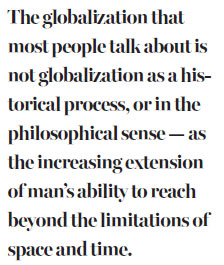That was globalization, but what next?
Updated: 2016-11-04 07:24
By Ed Zhang(China Daily Europe)
|
|||||||||
There is still no replacement for manufacturing to sustain the middle class; even technology doesn't do it
Now that a number of political events in 2016, most importantly Brexit and the US presidential election, seem to signal the advent of a de-globalization process, it might be a good time to take a serious look at what has gone wrong in the last few decades to make so many people unhappy about it.
The globalization that most people talk about is not globalization as a historical process, or in the philosophical sense - as with the increasing extension of man's ability to reach beyond the limitations of space and time.
Nor is it the globalization in pure economic theory. In theory it's good thing, if it means having more countries competing in a common legal framework in a common market. Who can say this isn't a good thing? As Kofi Annan, former UN secretary-general, once said: "Arguing against globalization is like arguing against the law of gravity".
However, in practice, as a force that seems to have turned so many people's everyday lives upside down, the most visible kind of globalization has been that of the manufacturing business. More specifically, it is the tendency for the free flow of capital to lead the world's major manufacturing activities - those using standard technologies and producing for general purposes - to always chase the lowest possible cost.

Otherwise, things like free trade wouldn't have spurred economic growth and kept generating the supply of low-price goods to consumers all over the world.
By the same token, whenever there is a rise in business costs - be they related to labor or environmental regulation - companies will start to relocate to wherever they can find abundant supply of inexpensive labor or a relatively relaxed regulatory regime (the two factors usually come side-by-side).
Since general manufacturing businesses (not those based on high technology) usually hire a substantial amount of low- and mid-skilled labor, when they flourish it can help sustain a society's off-farm jobs and its middle class's living standards. Jobs and income are, in turn, the two most basic factors that strengthen the legitimacy of a government.
But when the manufacturing business leaves, it leaves behind not only deserted factory towns but many unemployed workers who are unprepared for going back to farming or for learning new skills. The phenomenon of the "precariat" (a word is a combination "precarious" and "proletariat") can be seen as a direct social consequence of the withering of manufacturing.
The rise of a new stratum of urban poor who don't have regular jobs or full social security coverage is first of all the result of a shortage of manufacturing jobs, including the kind held by the traditional proletariat.
Service jobs are usually more poorly paid and protected. Technology industries don't usually generate many jobs for low- and mid-skilled workers directly. Even in the United States, the world's unquestionable champion in technology, the relocation of manufacturing can still leave a large job market vacuum.
The reality is that in any modern society, the social function of manufacturing as a force to sustain the jobs and livelihoods of the middle class has still not found a replacement. Even the technology industry in the US can't do it.

What should be done? Small wonder that a new crop of politicians has hastened to lay down the banner of globalization and start blowing the clarion of protectionism.
But this kind of deglobalization simply can't work.
Even if all the existing free trade pacts are overturned, people have already learned where to look for high efficiency and low prices. They will continue to do business the globalized way.
In the meantime, the problem is not just limited to the rich countries. In all large cities in the world, because of their relatively high costs, they tend to be the first places deserted by manufacturing. Therefore they also tend to hold large numbers of poorly paid young people.
In some parts of China, an internal effect of globalization is also obvious. External globalization has worked with internal capital to relocate manufacturing businesses away from the old industrial cities to the new ones. The so-called rust belt of the northeastern provinces is evidence of this.
For large developing countries like China and India, the future challenges will be enormous. Up to now, rich countries have not provided them with a formula for what to do when their manufacturing competitiveness has reached its peak.
The challenge will be to grow business activities that are more closely tied to the local society and local resources so they don't migrate to other places.
(China Daily European Weekly 11/04/2016 page13)
Today's Top News
Li promotes SCO bank, free trade
High Court: Parliament must vote before Brexit
Court to instruct how to trigger formal EU exit
Premier emphasizes fight against terror
Italian authorities vow to rebuild earthquake-hit areas
Li arrives in Kyrgyzstan for visit, SCO meeting
Xi affirms one-China policy
France to begin moving migrant minors from Calais
Hot Topics
Lunar probe , China growth forecasts, Emission rules get tougher, China seen through 'colored lens', International board,
Editor's Picks

|

|

|

|

|

|







